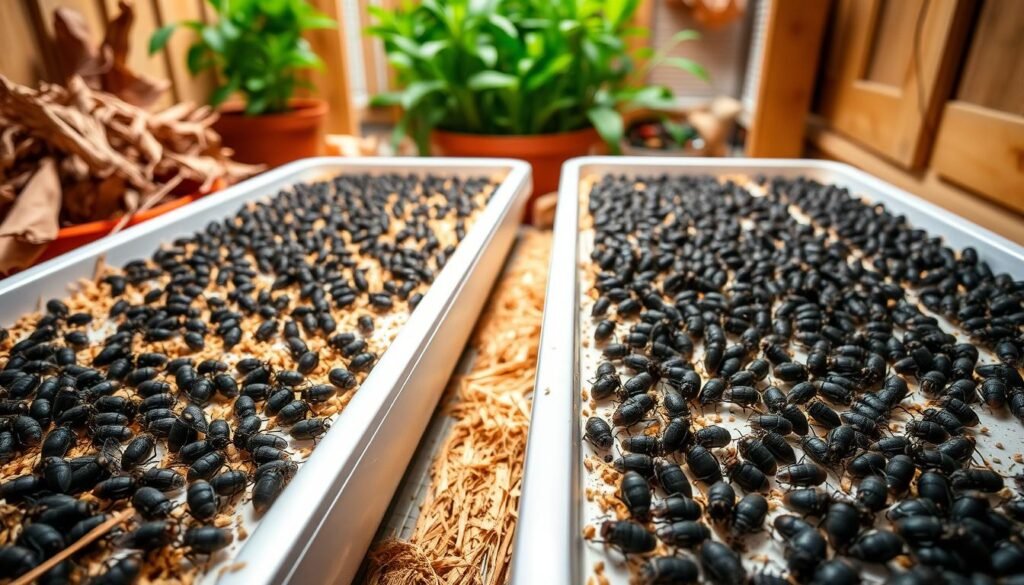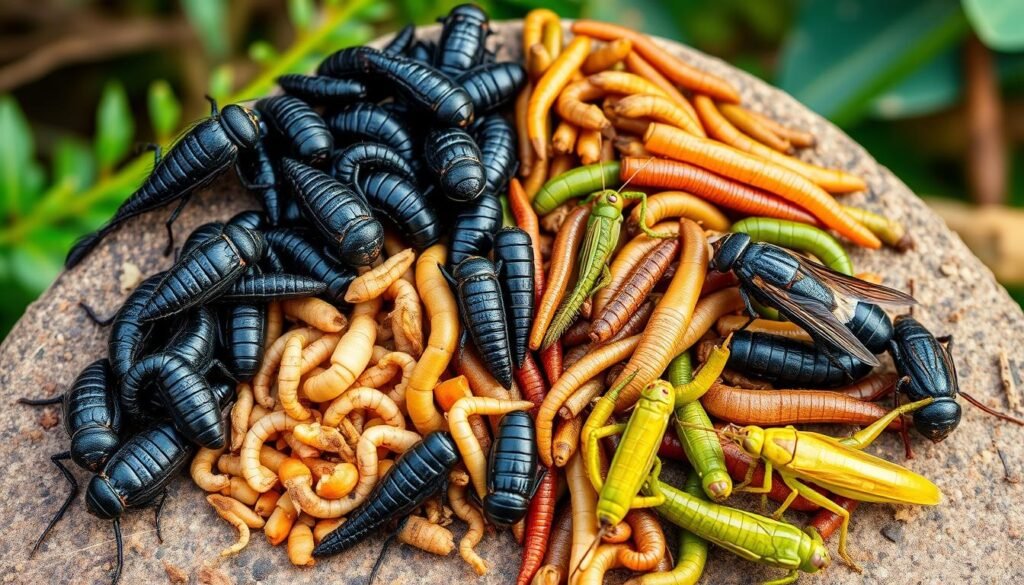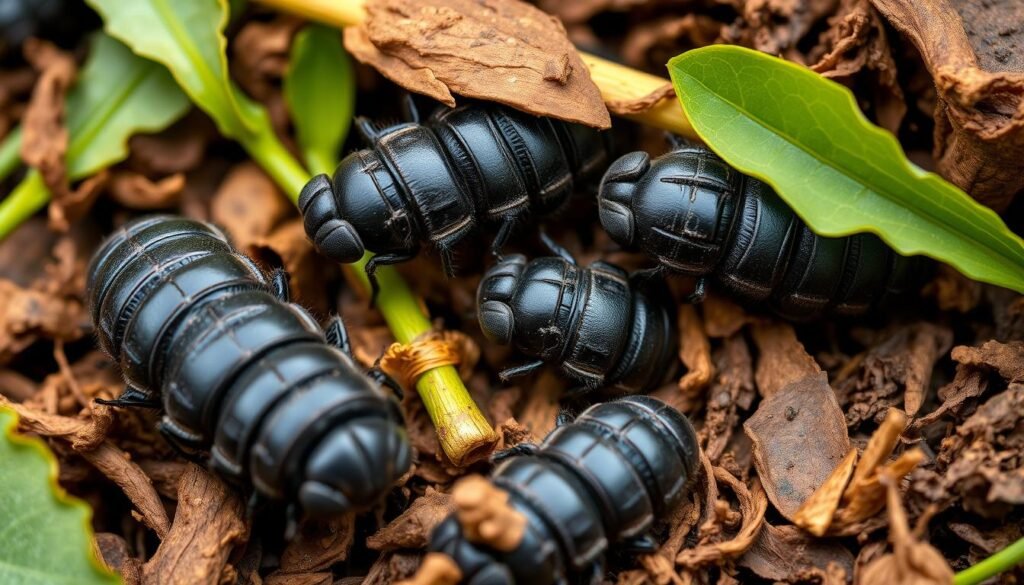Black soldier fly larvae (BSFL) are a promising alternative to traditional animal-based protein sources. These nutrient-dense insects efficiently convert organic waste into protein-rich biomass. This makes them ideal for sustainable agriculture and animal feed.
BSFL production requires fewer resources than conventional livestock farming. It’s more environmentally friendly and cost-effective. The larvae thrive on various organic waste materials, reducing environmental impact while producing valuable feed.
The growing global population has increased demand for alternative protein sources. BSFL offer a sustainable solution with their nutrient-dense and versatile protein. This protein can be used in animal feed and various food and industrial applications.
Table of Contents
ToggleKey Takeaways
- Black soldier fly larvae are a sustainable and environmentally friendly protein source.
- BSFL can efficiently convert organic waste into a nutrient-dense biomass for animal feed.
- BSFL production requires significantly fewer resources compared to traditional livestock farming.
- BSFL can play a key role in addressing the global need for alternative protein sources.
- BSFL production can contribute to a circular economy by reducing organic waste and producing a valuable protein-rich feed ingredient.
Introduction to Black Soldier Fly Larvae
Black soldier fly larvae offer a sustainable protein alternative to traditional livestock. These insects efficiently convert organic waste into nutrient-dense biomass. They’re a promising solution for eco-friendly food production.
Sustainable and Environmentally Friendly Protein Source
Black soldier fly larvae excel at waste conversion. They quickly transform various organic materials into protein-rich biomass. This process reduces waste and lessens the environmental impact of conventional farming.
High Nutritional Value and Versatility
These larvae are packed with nutrients. They contain high levels of protein, healthy fats, and essential vitamins and minerals. Their versatile composition makes them valuable for animal feed, pet food, and human consumption.
| Nutritional Profile Comparison | Black Soldier Fly Larvae | Mealworms |
|---|---|---|
| Protein Content | 40-50% | 20-22% |
| Lysine | 72% more than mealworms | – |
| Methionine | Over 2 times more than mealworms | – |
| Calcium-to-Phosphorus Ratio | Ideal for poultry needs | – |
Black soldier fly larvae are efficient and versatile. They offer a sustainable protein source for global demand. These insects can help address the need for eco-friendly protein options.
The Global Need for Alternative Protein Sources
By 2050, the world’s population may reach 10 billion. This growth will increase demand for protein-rich foods. Traditional livestock production harms the environment, causing various issues.
Rising Population and Food Demand
As the global population grows, so does the need for protein-rich foods. By 2050, cereal production must rise to 3.0 billion tons annually. Meat production will need to reach 455 million tons yearly.
Environmental Impact of Traditional Livestock Production
Livestock farming takes a toll on the environment. In Africa, it contributes to 30% of agricultural production value. In Kenya, it accounts for over 25% of agricultural GDP.
The industry has a heavy environmental footprint. Feed costs make up over 70% of poultry production costs in Kenya. This drives the need for sustainable, eco-friendly protein sources.
Black soldier fly larvae offer a promising solution. They can be produced using organic waste with a lower resource footprint than traditional livestock.
“Black soldier fly larvae are cheap to raise and have gained attention due to their unique nutritional composition, making them suitable for sustainable protein sources in feed for swine, poultry, and aquaculture.”
Black Soldier Fly Larvae as Animal Feed
Black soldier fly larvae (BSFL) are a valuable ingredient in animal feed. They’re rich in protein and nutrients, making them ideal for poultry, fish, and livestock. BSFL can replace traditional protein sources like soybean and fishmeal.
BSFL production uses organic waste, reducing environmental impact. This process turns waste into high-quality protein, supporting a sustainable food system.
Nutritional Benefits for Livestock and Poultry
BSFL contain up to 63% protein, similar to soybean meal’s 36-56%. They’re rich in essential amino acids like leucine, lysine, and valine.
These larvae provide vital minerals such as calcium, iron, and zinc. They also produce unsaturated fatty acids crucial for animal health.
Improved Performance and Health
Adding BSFL to animal feed boosts growth and overall health. Studies on broiler chickens show enhanced growth and better gut health.
In ruminants, BSFL affects rumen fermentation and methane emissions. This suggests they could contribute to sustainable livestock production.
| Nutrient | BSFL | Soybean Meal | Fish Meal |
|---|---|---|---|
| Protein | 33% – 63% | 36% – 56% | N/A |
| Leucine | Higher | Lower | Higher |
| Lysine | Higher | Lower | Higher |
| Valine | Higher | Lower | Higher |
| Methionine | Similar | Similar | Higher |
| Tryptophan | Similar | Similar | Higher |
This table compares nutrients in BSFL, soybean meal, and fish meal. It shows BSFL’s potential as a nutritious, sustainable animal feed ingredient.
Farming Black Soldier Fly Larvae
Farming BSFL (black soldier fly larvae) is simple and resource-efficient. These larvae grow on various organic waste types. They turn waste into a valuable protein source, supporting a circular economy.
Efficient Organic Waste Conversion
BSFL are great at turning organic materials into protein- and fat-rich biomass. They upcycle waste that might otherwise pollute the environment. This makes them a sustainable choice for protein production.
Low Resource Requirements
BSFL farming needs less land, water, and energy than traditional livestock farming. It’s a resource-efficient way to produce protein. This approach fits well with circular economy principles.

“Building a DIY black soldier fly larvae farm requires minimal investment of around $18, utilizing materials like a 55-gallon plastic bin, cinder blocks, starter feed, and corrugated cardboard.”
BSFL have a quick growth cycle. Eggs hatch in 4 days, and adults live for about 7 days. This ensures fast larvae production.
BSFL farming is scalable and cost-effective. It offers a sustainable solution for protein production. Its low resource needs make it ideal for various scales.
Nutritional Profile of Black Soldier Fly Larvae
Black Soldier Fly Larvae (BSFL) are a nutritious protein source. They contain up to 63% protein, rivaling soybean meal. BSFL offer an excellent alternative to traditional protein sources like fish meal.
BSFL excel in amino acid composition. They’re rich in essential amino acids like leucine, lysine, and valine. These levels surpass those in soybean and fish meal.
Methionine and tryptophan levels are slightly lower. However, BSFL still provide a balanced amino acid profile. This makes them valuable for animal feed and potential human food.
Fat and Fatty Acid Composition
BSFL have a favorable fat composition. They contain a high proportion of unsaturated fatty acids. These include oleic and linoleic acid.
This fatty acid profile promotes overall health. It makes BSFL a nutritious and sustainable alternative to traditional protein sources.
| Nutrient | Content in BSFL | Comparison to Soybean Meal | Comparison to Fish Meal |
|---|---|---|---|
| Protein | 33-63% | Higher | Comparable |
| Essential Amino Acids | Abundant, including high levels of leucine, lysine, and valine | Higher in some, comparable in others | Higher in some, comparable in others |
| Fatty Acids | High proportion of unsaturated fatty acids | Favorable composition | Favorable composition |
| Minerals | Rich in calcium, iron, magnesium, sodium, zinc, and potassium | Comparable | Comparable |
The BSFL nutritional profile is exceptional. It boasts high-quality protein and balanced amino acids. These features make BSFL promising for animal feed and human food.
Comparison with Other Edible Insects
Black soldier fly larvae (BSFL) stand out among edible insects as sustainable protein sources. They convert organic waste into protein-rich biomass more efficiently than crickets, mealworms, and grasshoppers. BSFL require fewer resources and produce less waste compared to other insect species.
BSFL’s nutritional profile makes them an attractive protein alternative. They contain about 40% protein, 28% fat, 10% fiber, and 3% calcium. In contrast, mealworms have 50% protein, 25% fat, 7% fiber, but very little calcium.
Efficiency and Sustainability
BSFL production excels in efficiency and sustainability. They convert food waste into biomass remarkably well, reducing carbon footprints. This makes them more eco-friendly than traditional livestock farming.
- BSFL require fewer inputs and resources, making them a cost-effective and sustainable protein source.
- BSFL farming produces significantly fewer greenhouse gas emissions than traditional livestock farming.
- Over 90% of the mealworms sold in the United States are imported, while BSFL are commonly grown domestically in the US and Canada.
Nutritional Advantages
BSFL offer a well-rounded nutritional profile that sets them apart from other edible insects. They boast high protein content and elevated levels of calcium and other essential nutrients.
“BSFL are a reliable source of protein, calcium, iron, and have elevated fat content that is utilized in producing various feeds.”
This nutritional edge makes BSFL ideal for animal feed and pet food. They’re also great for human food products like protein bars and powders.

Potential Benefits of Black Soldier Fly Larvae
BSFL offer numerous benefits as a protein source. They enhance environmental sustainability and cost-effectiveness. BSFL farming efficiently converts organic waste into valuable protein, promoting a circular economy.
Environmental Sustainability
BSFL can process organic waste efficiently, reducing its volume by up to 56%. This helps divert waste from landfills and addresses global waste management issues.
Abidjan, Côte d’Ivoire, produces over 6 million tonnes of waste daily. More than 60% is recoverable organic waste.
The FAO-supported circular economy approach could create 35,000 green jobs yearly in Abidjan alone. This potential exists if the system is well-managed.
Cost-effectiveness
BSFL offer cost-effectiveness advantages alongside environmental benefits. Using waste streams for BSFL production makes them a budget-friendly protein alternative.
Agricultural producers can reduce costs by using BSFL for waste management. This can make local products more competitive in various markets.
Organic waste recovery can lower municipal waste management budgets. It can also enable self-financing bioconversion centers to operate.
“Scaling up the BioDAF project into other cities and countries could revolutionize waste management in Africa and contribute to a greener, more sustainable future.”
Challenges and Considerations
Black Soldier Fly Larvae (BSFL) show promise as a sustainable protein source. However, several hurdles need addressing before widespread adoption. Regulatory landscapes vary across countries, with some regions still approving BSFL-based products.
Regulatory Landscape
BSFL-derived products face complex regulatory frameworks. Each country has unique rules for insects in food and feed industries. In the US, the FDA oversees safety of BSFL-derived food ingredients.
Navigating these requirements can be challenging for BSFL producers and manufacturers. Compliance with various regulations is crucial for market entry and success.
Potential Allergic Reactions
BSFL contain chitin, a substance also found in crustaceans. This poses a risk for individuals with shellfish allergies. They may experience adverse reactions when consuming BSFL-based products.
Addressing food safety concerns is vital for broader acceptance of BSFL. This will help establish BSFL as a mainstream protein source.
BSFL producers must work closely with regulatory authorities to meet safety standards. More research is needed to understand and mitigate allergy risks. Addressing these issues will help the BSFL industry grow sustainably.
| BSFL Challenges | Description |
|---|---|
| Regulatory Landscape | Varying regulations across countries, ongoing approval process for BSFL-based products |
| Potential Allergic Reactions | BSFL contain chitin, which may trigger reactions in individuals with shellfish allergies |
“Addressing these regulatory and safety concerns will be crucial for the wider adoption of BSFL as a mainstream protein source.”
Black Soldier Fly Larvae Research and Development
Scientists are focusing on black soldier fly larvae (BSFL) genetics, biology, and nutrition. They aim to improve BSFL production and explore new commercial uses. This research is vital for advancing sustainable insect protein.
Genetics and Biology Studies
Researchers are enhancing BSFL growth and nutrition through genetic studies. They’re developing better farming techniques by understanding insect biology and behavior.
Studies explore larvae life cycles and responses to environmental factors. This research drives the adoption of BSFL as a sustainable protein source.
Nutritional Advancements
Nutrition studies analyze BSFL protein, amino acids, fats, and fatty acids. Scientists aim to boost nutritional value by optimizing diet and rearing conditions.
These efforts create more versatile BSFL with expanded commercial potential. The goal is to make BSFL a robust and adaptable protein alternative.
BSFL R&D unlocks the potential of this sustainable, cost-effective protein source. Ongoing research shapes the future of this eco-friendly solution as global demand grows.
The Future of Black Soldier Fly Larvae Production
Black soldier fly larvae (BSFL) production is on the rise. These insects can turn organic waste into nutritious protein. BSFL could help solve food security and environmental issues.
The global BSFL market was worth $128 million in 2019. It’s expected to reach $3.4 billion by 2030. This growth comes from the need for new protein sources.
BSFL production offers many environmental benefits. They can convert various organic waste into nutrient-rich fertilizer called “frass.” Frass production has a lower impact than traditional organic fertilizers.
The future of BSFL looks promising. Ongoing research and growing acceptance of insects as food will help. BSFL production is set to expand, creating a more sustainable food system.
| Key Statistics | Value |
|---|---|
| Global BSFL market value (2019) | $128 million |
| Projected BSFL market value (2030) | $3.4 billion |
| Asia Pacific market share (2019) | 57.1% (volume), 50% (value) |
| Estimated annual BSFL farming | 200-300 billion individuals |
| Projected insect protein demand (2030) | 500,000 metric tons |
BSFL production offers a sustainable solution for protein-rich foods. It supports a circular economy and boosts food security worldwide. The future of BSFL looks bright indeed.
Conclusion
Black soldier fly larvae are a promising sustainable protein source. They can meet global protein demand while reducing environmental impact. BSFL efficiently convert organic waste into nutrient-dense biomass, making them valuable for various applications.
BSFL have a favorable nutritional profile and versatility. They can be used in animal feed and human food. Research and development efforts continue to advance their potential.
Regulatory frameworks are adapting to accommodate insects as food and feed. The future of BSFL production looks bright. They may play a significant role in building a sustainable food system.
BSFL have high protein content and favorable fatty acid composition. They can contribute to food security and environmental sustainability globally. Their efficient waste conversion capabilities make them an attractive solution.
These larvae address pressing challenges of our time. They offer an alternative protein source and reduce food production’s environmental footprint. BSFL showcase how innovative approaches can create a more resilient future.
FAQ
What are black soldier fly larvae (BSFL)?
Black soldier fly larvae are a fly species with great potential as a sustainable protein source. They efficiently turn organic waste into nutrient-rich biomass. This includes food scraps and agricultural byproducts.
What are the benefits of using BSFL as a protein source?
BSFL are a sustainable and eco-friendly protein option. They require fewer resources than traditional livestock and can be produced using organic waste. BSFL are also highly nutritious, packed with protein, healthy fats, and essential nutrients.
How can BSFL be used in animal feed?
BSFL are valuable in animal feed formulations for poultry, fish, and livestock. Their high protein content and nutritional value make them suitable replacements for traditional protein sources. They can effectively substitute soybean meal and fishmeal in feed.
What are the key advantages of BSFL farming?
BSFL farming is highly resource-efficient, converting organic waste into valuable protein. This process contributes to a more circular economy and reduces environmental impact. BSFL production using waste streams can be a cost-effective alternative to traditional protein sources.
What are the potential challenges with BSFL as a food and feed ingredient?
Regulations for using insects in food and feed vary across countries. In some regions, approval for BSFL-based products is still ongoing. There’s also a potential risk of allergic reactions due to chitin in BSFL.
What is the future of BSFL production?
The future of BSFL production looks promising as global demand for protein-rich foods grows. BSFL could play a significant role in addressing food security and environmental challenges. Ongoing research and increasing regulatory acceptance are expected to drive BSFL production expansion.

